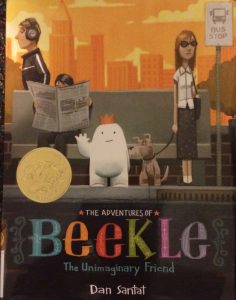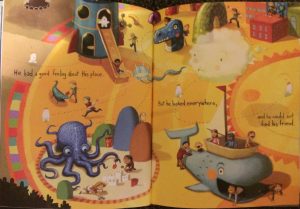Author and Illustrator: Dan Santat
Publisher and Year: Little, Brown and Company, 2014 (2015 Caldecott Winner)
Number of Pages: 38 Pages
Genre: Fantasy, Realistic Fiction
The Adventures of Beekle follows Beekle’s journey in finding his human friend. Instead of waiting for his friend to imagine him in his imaginary world, he courageously decides to go into the real world (the city) in search for his best friend.
As a mirror, it reflects a child’s creation of an imaginary friend. As a window, the story serves a unique view into how an imaginary friends view the “human world.” As a door, the reader is invited into the world of the creation of a child and his or her imaginary friend. In the beginning, the children hold the power because each imaginary friend anxiously waits to be found by a human friend. Beekle took control of his life, was tired of waiting, and did the unthinkable: set out to the real world to find his friend. Beekle quickly learned the “real world” was very different from anything he had ever imagined. The real world was not filled with creativity like his land was. However, he befriends a girl and they go on adventures to help bring imaginary friends to the real world. This power shift stands for the power of a child and his or her imagination. Though Beekle is a white “blob,” the people in a real world represent diverse races and cultures. This shows that the author/illustrator wanted to make this book relatable to children of all races and cultures. No specific human culture is being represented in this book. Instead, the culture is children. This book highlights the importance and benefit of creativity in diverse friendships.
Perceptually, lively colors are used in the imaginary world to symbolize the happiness among the imaginary people awaiting their human friends. On the contrary, dull colors are used in the real world to show how as people age, the world becomes less imaginative. However, the one place in the real world were bright colors are used is the park, where other imaginary friends are shown. This shows the reader that being outside can allow imagination to run free. Also, Beekle wears a crown, symbolizing he is different than his other imaginary friends. With this book being a Caldecott winner, artwork is heavily emphasized in this book. Through the artwork of the author/illustrator, the artwork portrays the creativity of children with the bright colors in the book. In addition, minimal words are used because the author heavily emphasized on the artwork. This was possibly done on purpose so that younger readers would look at the colors on the pages of the book and be inspired to let their imagination take them on an adventure. Also, the author makes the text look handwritten possibly symbolizing his personal journey presented through this story.
The most prevalent themes found in this whimsical story are that power lies within imagination, friends are found in unlikely shapes and sizes, it takes courage to face the real world, and imagination can bring happiness that never has an expiration date.


